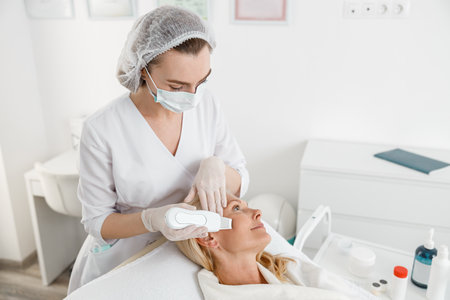Introduction to IPL and Skin Clarity
When it comes to achieving a brighter, clearer complexion, Intense Pulsed Light (IPL) technology has become a popular choice across the UK. IPL is a non-invasive cosmetic procedure that harnesses broad-spectrum light to target various skin concerns, including pigmentation, redness, and uneven skin tone. Unlike traditional laser treatments that use a single wavelength, IPL emits multiple wavelengths of light, making it versatile for treating different skin issues in one go. Over recent years, IPL treatments have seen widespread adoption in British clinics and beauty salons due to their effectiveness and minimal downtime. As more people in the UK seek safe and efficient solutions for skin clarity, understanding how IPL works becomes ever more important. Essentially, the pulses of light penetrate the skin’s surface and are absorbed by pigment or blood vessels beneath, breaking down unwanted melanin or reducing redness without harming surrounding tissue. This process encourages natural healing and regeneration, leading to visibly clearer and smoother skin over time. Whether youre considering IPL for sun spots, freckles, or general rejuvenation, knowing the basics of this technology will help you make informed decisions about your skincare journey in the UK.
2. Benefits of IPL for Skin in the UK
Intense Pulsed Light (IPL) treatments have gained significant traction across the UK, largely due to their versatility and effectiveness in addressing common British skin concerns. Given the UKs often unpredictable climate and limited sunlight, many people experience issues such as pigmentation, redness, and sun damage. IPL offers a non-invasive solution that targets these problems at their source, making it an attractive option for those seeking clearer, more even-toned skin.
Addressing Pigmentation and Sun Damage
Pigmentation irregularities—like freckles, age spots, and melasma—are frequently observed among UK residents. This can be attributed to intermittent sun exposure and genetic factors. IPL works by emitting broad-spectrum light that penetrates the skin and breaks down excess melanin responsible for dark spots. Over time, treated areas become lighter and blend more seamlessly with the surrounding skin.
Reducing Redness and Rosacea
Redness, especially from conditions such as rosacea or broken capillaries, is another prevalent concern in the UK due to sensitive skin types and varying weather conditions. IPL targets haemoglobin in blood vessels, helping to minimise visible redness and create a more balanced complexion. Many patients notice a reduction in flushing and overall skin sensitivity after a series of treatments.
Summary Table: Key Benefits of IPL for UK Skin Concerns
| Skin Concern | How IPL Helps |
|---|---|
| Pigmentation (freckles, sun spots) | Targets melanin to fade dark spots |
| Redness (rosacea, capillaries) | Reduces visible blood vessels and soothes inflammation |
| Sun Damage | Stimulates collagen production for overall clarity |
Ultimately, IPL provides a flexible approach suitable for various skin types commonly found in the UK. Its ability to target multiple issues in one treatment protocol makes it a popular choice for those looking to refresh their appearance with minimal downtime.

3. What to Expect During an IPL Session
For anyone considering IPL (Intense Pulsed Light) treatment in the UK, understanding what happens during a typical session can help set realistic expectations and ease any pre-treatment nerves. Here’s a clear walkthrough of the process, including common local terminology and practical insights into comfort and results.
Consultation and Patch Test
Your journey usually begins with an initial consultation at a reputable clinic—often referred to as a “skin clinic” or “aesthetics clinic” on the high street. Here, a practitioner will assess your skin type, discuss your goals, and carry out a mandatory patch test. This is standard practice across the UK to ensure your skin reacts safely to the IPL device.
The Day of Your Treatment
On the day itself, you’ll be asked to arrive with clean skin—no makeup or skincare products. The practitioner will cleanse the treatment area again and may apply a cooling gel for added comfort, a step sometimes called “prepping the skin.” You’ll also be provided with protective eyewear, which is non-negotiable due to the bright pulses of light.
The Procedure Step-by-Step
The actual IPL procedure involves placing a handheld device against your skin. When activated, it emits gentle flashes of light targeting pigmentation or redness beneath the surface. In British clinics, you might hear practitioners refer to this as “flashing” or “zapping.” Most people describe the sensation as feeling like a warm flick or the snap of an elastic band—uncomfortable but generally tolerable. For those concerned about sensitivity, many UK clinics offer numbing creams upon request.
Duration and Comfort
A single session typically lasts anywhere from 20 to 45 minutes, depending on the size of the area being treated. While mild redness or warmth is common immediately after, you’re unlikely to need downtime—a key reason why IPL has become so popular in busy British cities.
Realistic Results and Aftercare
It’s important to note that visible improvements are gradual rather than instant. Most clients notice clearer, more even skin after three to six sessions spaced a few weeks apart. British clinics emphasise realistic expectations: IPL is not a miracle cure but an effective tool when used consistently within a well-managed skincare routine.
Final Thoughts
Overall, the typical IPL experience in the UK is straightforward and designed for comfort and safety. By knowing what to expect from start to finish—and by choosing qualified local practitioners—you can approach your first session with confidence and clarity.
4. Preparing for IPL Treatment – British Considerations
If you’re considering IPL (Intense Pulsed Light) therapy in the UK, thoughtful preparation is key to achieving the best results while staying compliant with local standards and recommendations. Here’s a practical guide tailored for those living in Britain, focusing on timing, aftercare, and essential regulatory details.
Seasonal Timing: When to Book Your IPL Sessions
The British climate plays a significant role in your IPL journey. Due to lower sun exposure during autumn and winter, these seasons are often considered ideal for starting treatment. UV exposure can increase the risk of complications post-IPL, so scheduling sessions when you’re less likely to be outdoors is a wise move.
| Season | Advantages | Considerations |
|---|---|---|
| Autumn/Winter | Reduced sun exposure, easier aftercare | Book early as clinics are busier |
| Spring/Summer | More appointment flexibility | Avoid direct sunlight; use high-factor SPF religiously |
Aftercare: British Lifestyle Tips
- Avoid Sunbeds: Sunbeds are popular in some UK regions but should be strictly avoided before and after treatment.
- Weather Protection: Always use a broad-spectrum SPF 30+ even on cloudy days—remember, British weather can be unpredictable!
- Gentle Skincare: Choose fragrance-free moisturisers and avoid harsh exfoliants for at least one week post-session.
- No Swimming Pools or Spas: Chlorinated water can irritate treated skin—hold off for a few days.
Understanding UK Regulations and Recommendations
The UK has specific guidelines regarding who can perform IPL treatments. Ensure your practitioner is qualified and that the clinic is registered with the relevant local authority (such as the Care Quality Commission in England or HIS in Scotland). Ask to see credentials and check for membership in professional bodies like the British Association of Beauty Therapy & Cosmetology (BABTAC).
Regulatory Checklist Before Booking Your Appointment:
- Clinic registration with local authority
- Practioner qualifications (Level 4 or above recommended)
- Satisfactory patch test performed prior to treatment
- Clear consultation explaining risks and realistic outcomes
A Final Word on Preparation in the UK Context
The blend of variable weather, robust health regulations, and diverse lifestyles in Britain means that preparing for IPL here requires careful planning. By understanding these uniquely British factors, you’ll maximise both your safety and your results.
5. Side Effects, Safety, and Choosing a UK Clinic
When considering IPL for skin clarity in the UK, understanding potential side effects and prioritising safety is essential. Below, we break down the most common experiences, outline the safety protocols reputable clinics follow, and offer guidance on selecting a trusted provider.
Common Side Effects of IPL Treatments
Most individuals experience mild and temporary side effects after IPL sessions. These can include:
- Redness and Swelling: The treated area may look flushed or slightly puffy for a few hours post-treatment—this is normal and usually subsides quickly.
- Sensitivity: Your skin might feel warm or tingly, similar to mild sunburn.
- Pigment Changes: Rarely, some people notice temporary darkening or lightening of the skin.
Severe reactions are rare but can include blistering or infection if aftercare instructions are not followed. Always discuss your medical history with your practitioner before starting treatment.
Safety Protocols in UK Clinics
The UK has strict regulations for IPL devices and practitioners. Registered clinics are required to:
- Carry out patch tests before commencing a full course of treatments to ensure you don’t react adversely.
- Employ trained professionals who understand how to tailor settings for different skin types.
- Use equipment that meets British safety standards (look for CE marking and regular maintenance logs).
A responsible clinic will also provide comprehensive aftercare advice and be transparent about possible risks.
Selecting a Properly Registered and Reputable Provider
The quality of your results—and your safety—depend on choosing the right clinic. Here’s what to look for in the UK context:
- Regulatory Registration: Check that the clinic is registered with the Care Quality Commission (CQC) or an equivalent body if required for their services.
- Qualified Staff: Practitioners should hold relevant qualifications, such as NVQ Level 4 in laser and light therapies, and be able to show ongoing training certificates.
- Transparent Consultation Process: A reputable provider will offer a thorough consultation, answer all questions honestly, and never pressure you into unnecessary treatments.
Final Thoughts
Your wellbeing should always come first. By recognising side effects, insisting on proper safety measures, and choosing a properly registered UK clinic, you’ll be well-positioned to enjoy the benefits of IPL safely and confidently.
6. Aftercare and Maintaining Results in the UK Climate
Proper aftercare is vital to maximise the benefits of your IPL treatment, especially considering the unique weather conditions across the UK. The changeable British climate—often damp, windy, and prone to sudden shifts—can have a noticeable effect on your skin’s healing and long-term clarity. Here are some key considerations and practical tips for maintaining radiant results after your IPL sessions.
Immediate Post-Treatment Care
Right after your IPL session, your skin may feel sensitive or slightly sunburnt. It’s important to avoid hot showers, saunas, or vigorous exercise for at least 24 hours. Instead, use cool water and gentle cleansers to soothe the area. Given the UK’s frequent drizzle and chill, remember to pat skin dry gently if caught in the rain—rubbing can exacerbate irritation. Avoid using harsh exfoliants or active ingredients like retinol until any redness or swelling subsides.
Sun Protection All Year Round
Although the British Isles aren’t renowned for intense sunshine, UV exposure is still a concern—even on overcast days. Apply a broad-spectrum SPF 30+ every morning, regardless of the season. This shields treated skin from UV rays that can trigger pigmentation changes post-IPL. Consider carrying a travel-sized sunscreen in your bag for top-ups when out and about, especially during rare sunny spells.
Hydration: Inside and Out
The UK’s often brisk winds and indoor heating can leave skin parched. Keep your skin barrier strong by using a good-quality moisturiser, ideally fragrance-free to minimise irritation. Drinking plenty of water throughout the day also helps flush out toxins and keeps your complexion clear. For those living in areas with hard water—common in parts of England—a hydrating serum containing hyaluronic acid can offer extra relief.
Building a Long-Term Skincare Routine
To prolong the effects of IPL, establish a consistent skincare regime tailored to your needs. Gentle cleansing, regular moisturising, and diligent sun protection form the foundation. If you’re keen on further improvements, consult your practitioner about incorporating antioxidants like vitamin C or periodic professional treatments suited for British skin types.
Maintaining Clarity Between Sessions
Results from IPL can be maintained with occasional touch-up sessions as recommended by your clinic—often once or twice per year depending on your skin concerns and goals. In between appointments, stick to healthy habits: avoid smoking, limit alcohol intake, eat a balanced diet rich in fruits and vegetables, and manage stress levels. These lifestyle choices complement treatment outcomes and support overall skin health.
By adapting your aftercare routine to suit the UK’s unique climate—and committing to daily maintenance—you’ll enjoy clearer, brighter skin long after your initial IPL treatment.

